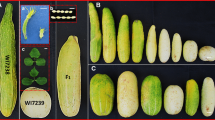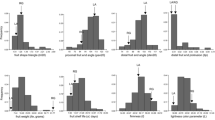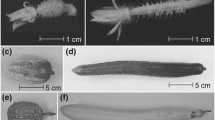Abstract
Fruit shape is a quantitatively inherited character. In tomato, two major loci, sun and ovate, control fruit shape index, which is the ratio of fruit height over width. In this study, we measured many additional fruit shape features in three inter-specific F2 populations using the software application Tomato Analyzer. These populations were derived from varieties carrying elongated fruit but for which the major shape loci differed. We compared the effect of the major fruit shape loci with overall shape, as well as with the distal and proximal end shape features in each population. sun and ovate represented the largest effect on fruit shape in the Howard German and Sausage F2 populations, respectively. The largest effect QTL in the Rio Grande population carrying neither sun nor ovate, were fs8.1 on chromosome 8 and tri2.1/dblk2.1 on chromosome 2. These latter loci were also segregating in the other two populations, thus indicating common regions that control shape across the three populations. The phenotypic analyses showed that sun and ovate contributed to almost all aspects of shape such as the distal and proximal end features. In Rio Grande however, the largest effect QTL did not control all aspects of shape and the distal and proximal features were distinctly controlled in that population. Combined, our results implied that within the cultivated tomato germplasm pool the largest effect on elongated fruit shape was controlled by a combination of the loci sun, ovate, fs8.1 and tri2.1/dblk2.1.


Similar content being viewed by others
References
Barrero LS, Cong B, Wu F, Tanksley SD (2006) Developmental characterization of the fasciated locus and mapping of Arabidopsis candidate genes involved in the control of floral meristem size and carpel number in tomato. Genome 49:991–1006
Bernatzky R, Tanksley SD (1986) Toward a saturated linkage map in tomato based on isozymes and random cDNA sequences. Genetics 112:887–898
Brewer MT, Lang L, Fujimura K, Dujmovic N, Gray S, van der Knaap E (2006) Development of a controlled vocabulary and software application to analyze fruit shape variation in tomato and other plant species. Plant Physiol 141:15–25
Brewer MT, Moyseenko JB, Monforte AJ, van der Knaap E (2007) Morphological variation in tomato fruit: a comprehensive analysis and identification of loci controlling fruit shape and development. J Exp Bot 58:1339–1349
Churchill GA, Doerge RW (1994) Empirical threshold values for quantitative trait mapping. Genetics 138:963–971
Frary A, Nesbitt TC, Frary A, Grandillo S, van der Knaap E, Cong B, Liu J, Meller J, Elber R, Alpert KB, Tanksley SD (2000) fw2.2: A quantitative trait locus key to the evolution of tomato fruit size. Science 289:85–88
Fulton T M, Chunwongse J, Tanksley SD (1995) Microprep protocol for extraction of DNA from tomato and other herbaceous plants. Plant Mol Biol Rep 13:207–209
Grandillo S, Ku HM, Tanksley SD (1996) Characterization of fs8.1, a major QTL influencing fruit shape in tomato. Mol Breed 2:251–260
Kosambi DD (1944) The estimation of map distances from recombination values. Ann Eugen 12:172–175
Ku HM, Grandillo S, Tanksley SD (2000) fs8.1, a major QTL, sets the pattern of tomato carpel shape well before anthesis. Theor Appl Genet 101:873–878
Ku HM, Doganlar S, Chen KY, Tanksley S D (1999) The genetic basis of pear-shaped tomato fruit. Theor Appl Genet 99:844–850
Lander ES, Green P, Abrahamson J, Barlow A, Daly MJ, Lincoln SE, Newburg L (1987) MAPMAKER: an interactive computer package for constructing primary genetic linkage maps of experimental and natural populations. Genomics 1:174–181
Liu J, Van Eck J, Cong B, Tanksley SD (2002) A new class of regulatory genes underlying the cause of pear-shaped tomato fruit. Proc Natl Acad Sci USA 99:13302–13306
Van der Knaap E, Lippman ZB, Tanksley SD (2002) Extremely elongated tomato fruit controlled by four quantitative trait loci with epistatic interactions. Theor Appl Genet 104:241–247
Van der Knaap E, Tanksley SD (2003) The making of a bell pepper-shaped tomato fruit:identification of loci controlling fruit morphology in Yellow Stuffer tomato. Theor Appl Genet 107:139–147
Wang S, Basten CJ, Zeng Z-B (2006) Windows QTL Cartographer 2.5. Department of Statistics, North Caroline State University, Raleigh, NC. http://statgen.ncsu.edu/qtlcart/WQTLCart.htm
Zeng ZB (1993) Theoretical basis for separation of multiple linked gene effects in mapping quantitative trait loci. Proc Natl Acad Sci USA 90:10972–10976
Zeng ZB (1994) Precision mapping of quantitative trait loci. Genetics 136:1457–1468
Acknowledgments
This work was supported by National Science Foundation grants DBI 0227541 and DBI 0400811. MJ Gonzalo was also supported by a fellowship EX2004-0293 from The Ministry of Education and Science of Spain. We thank the Ohio Bioproducts Innovation Center for use of equipment, Jenny Moyseenko for plant care and Marin Brewer for assistance with genotyping of the RG population.
Author information
Authors and Affiliations
Corresponding author
Additional information
Communicated by C. Hackett.
Electronic supplementary material
Below is the link to the electronic supplementary material.
122_2007_698_MOESM1_ESM.doc
Supplementary Table S1. Correlation matrix of the 14 fruit shape attributes by population. (a) Correlation matrix for Howard German F2 population, (b) Correlation matrix for Sausage F2 population and (c) Correlation matrix for Rio Grande F2 population. The significant values at P < 0.0001 are highlighted. The attributes included in the boxes are highly correlated between them (doc 77 kb)
Rights and permissions
About this article
Cite this article
Gonzalo, M.J., van der Knaap, E. A comparative analysis into the genetic bases of morphology in tomato varieties exhibiting elongated fruit shape. Theor Appl Genet 116, 647–656 (2008). https://doi.org/10.1007/s00122-007-0698-7
Received:
Accepted:
Published:
Issue Date:
DOI: https://doi.org/10.1007/s00122-007-0698-7




